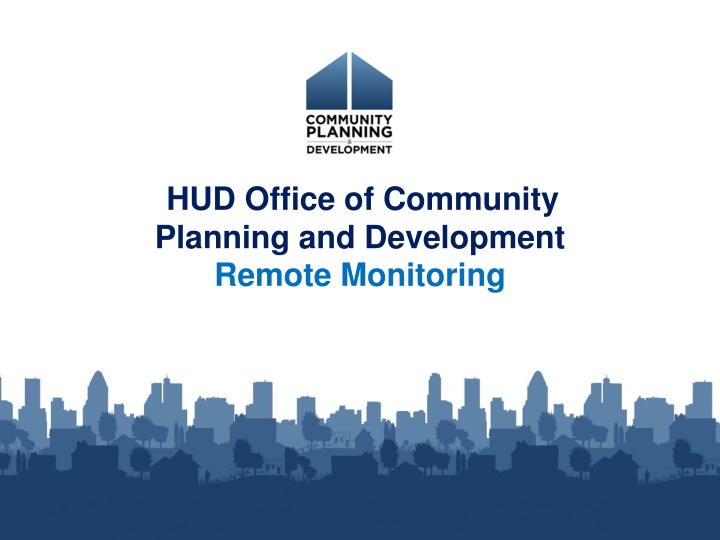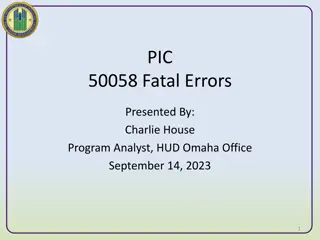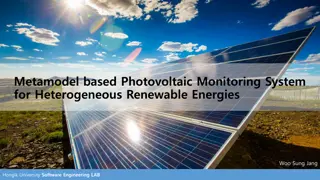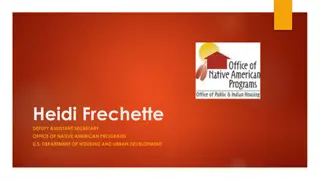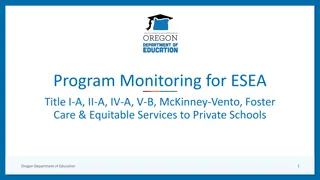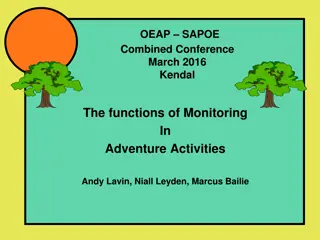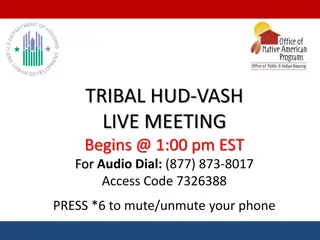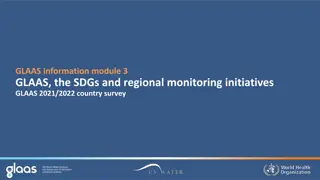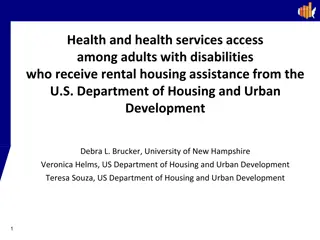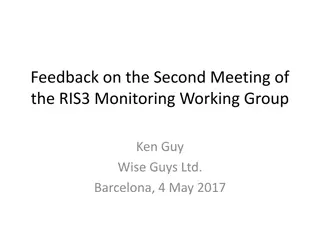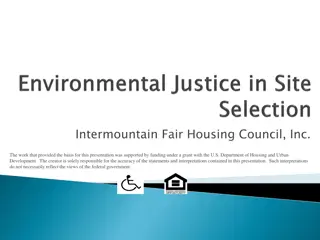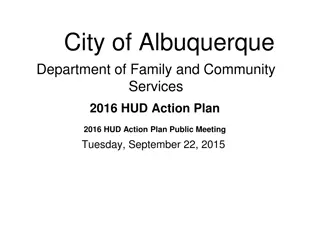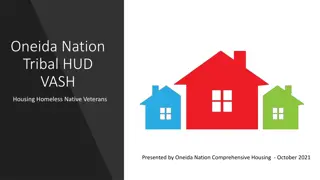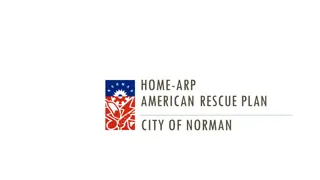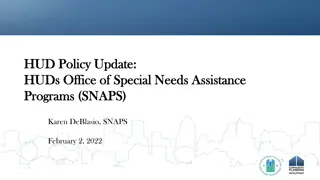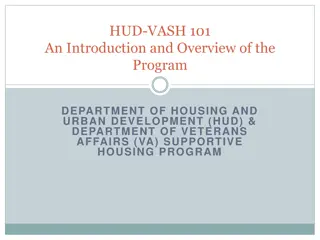HUD Office of Community Planning and Development Monitoring Process
This content provides an overview of the remote monitoring process conducted by the HUD Office of Community Planning and Development. It includes details on pre-monitoring, risk analysis, monitoring strategy, in-depth monitoring, remote monitoring, and more. The purpose of monitoring, conducted off-site based on information from grantees, is explained along with the steps involved in pre-monitoring, risk analysis, and developing a monitoring strategy. The content emphasizes determining compliance, preventing deficiencies, and designing corrective actions to improve grantee performance. It also covers conducting on-site interviews, entrance and exit conferences, and post-monitoring activities.
Download Presentation

Please find below an Image/Link to download the presentation.
The content on the website is provided AS IS for your information and personal use only. It may not be sold, licensed, or shared on other websites without obtaining consent from the author.If you encounter any issues during the download, it is possible that the publisher has removed the file from their server.
You are allowed to download the files provided on this website for personal or commercial use, subject to the condition that they are used lawfully. All files are the property of their respective owners.
The content on the website is provided AS IS for your information and personal use only. It may not be sold, licensed, or shared on other websites without obtaining consent from the author.
E N D
Presentation Transcript
HUD Office of Community Planning and Development Remote Monitoring
Agenda Pre-Monitoring Risk Analysis Monitoring Strategy Monitoring Exhibits Monitoring Notification Letter Grantee Document Exchange (GDX) Conducting Remote Monitoring Entrance Conference Interviews Meetings/Q&A Exit Conference Post Monitoring Monitoring Letter and Report Follow-up 2
Purpose of Monitoring Why does HUD conduct monitoring? Determine compliance, Prevent and identify deficiencies, Design corrective actions to improve or reinforce grantee performance, and Provide opportunities to identify grantee best practices. 3
In-depth Monitoring A detailed compliance review for a selected grantee; A concentrated review of specific activities, projects or programs; and/or A review of known high-risk areas or critical functions. 4
Remote Monitoring Conducted off-site Based upon analysis of information from the grantee, including interviews Information forming the basis for remote monitoring conclusions can incorporate review of performance reports and audited financial statements, information in databases, and other documentation submitted by the grantee ***SAME PROCESS AS ON-SITE MONITORING*** 5
Pre-Monitoring Conduct Risk Analysis Develop Monitoring Strategy Select Monitoring Exhibits Send-out Monitoring Notification Letter Grantee submits data via the Grantee Document Exchange (GDX) 6
Risk Analysis All HUD CPD programs are assessed annually to determine risk, based on a set of factors. Based on a 100-point rating scale, grantees are assigned one of three risk categories: High risk a total score of 51 or more Medium risk a score between 30 50 Low risk a score of less than 30 7
Monitoring Strategy Review Consolidated Plan and Annual Action Plan Review Consolidated Annual Performance and Evaluation Report (CAPER) Review Annual Performance Reports (APRs) Review any open activities and grant progress Review any open findings from previous HUD monitoring and/or OIG Audit Consider any other unresolved or on-going grantee issues 8
Monitoring Exhibits COMMONLY USED MONITORING EXHIBITS CHAPTER 3: COMMUNITY DEVELOPMENT BLOCK GRANT (CDBG) ENTITLEMENT, SMALL CITIES, NON ENTITLEMENT CDBG GRANTS IN HAWAII, AND INSULAR AREAS PROGRAMS CHAPTER 4: STATE COMMUNITY DEVELOPMENT BLOCK GRANT (CDBG) PROGRAM CHAPTER 7: HOME INVESTMENT PARTNERSHIPS PROGRAM (HOME) CHAPTER 28: EMERGENCY SOLUTIONS GRANTS (ESG) PROGRAM CHAPTER 29: CONTINUUM OF CARE (CoC) PROGRAM CHAPTER 34: 2 CFR PART 200, UNIFORM ADMINISTRATIVE REQUIREMENTS, COST PRINCIPLES, AND AUDIT REQUIREMENTS FOR FEDERAL AWARDS CHAPTER 22: FAIR HOUSING AND EQUAL OPPORTUNITY CHAPTER 24: LEAD-BASED PAINT COMPLIANCE 9
HUD Grantee Document Exchange (GDX) What is HUD GDX? The Grantee Document Exchange (GDX) is an external, secure platform outside of the HUD firewall that lets HUD share documents from a monitoring session and build a list of documents related to the monitoring so that grantee users from other systems can log on and submit requested documents along with notes. GDX Log-In*: https://drgr.hud.gov/gdx/ *It is important that all users open application in Chrome or Edge and do not use outdated and unsupported browsers such as Internet Explorer.
GDX (continued) Grantees access shared documents and/or bundles through an externally-accessible portal application GDX portal only displays those sessions for which documents have been requested or where documents have been shared GDX user sees shared documents and request bundles categorized by monitoring session start and end dates Grantee responds to requests in the bundle; Bundle response not viewable by HUD until sent. Once completed, grantee sends its response bundle to HUD for review. GDX accessible only by grantees.
GDX (continued) When a document request has been sent to a grantee with the link, they can log into GDX to see their request bundles. Grantees will have edit rights for their request bundles until they have been submitted to HUD. Once submitted to HUD, those bundles become view only so make sure to include all documents requested if possible. If HUD indicates there is a document still needed at that point, they will have to create a new bundle.
Conducting Remote Monitoring Entrance Conference Interviews Meetings/Q&A Exit Conference 16
Entrance Conference What happens at the entrance conference? Staff introductions Discuss Risk process and why grantee was selected for monitoring Identify/confirm key grantee staff who will assist during the monitoring Review the program areas/activities to be monitored Set-up or confirm meeting or interview times Discuss any opportunity for T.A. Discuss any challenges 17
Interviews with Staff o Interviews with grantee staff are conducted throughout the monitoring week, based on the program area being reviewed. o Interviews are also scheduled with subrecipients and clients, to clarify and determine the accuracy of the information, assess level of satisfaction with the provision of services or the end products, and document performance. o Interviews are scheduled via Teams, conference call-in numbers, or telephone. 18
Interviews with Staff (continued) Grantee staff should be prepared to: Respond to questions on the monitoring exhibits, Be able to provide justification for responses, Be available to answer any questions the HUD reviewer may have, and Be prepared to provide any additional information and documentation requested by the HUD reviewer. 19
Daily Q&A Meetings Throughout the monitoring, it is important to communicate and keep an on-going dialogue with the HUD reviewer. The HUD reviewer will set-aside some time each day to: Check-in with staff and discuss monitoring progress, Discuss any problem areas encountered to provide grantee staff an opportunity to make on-the-spot adjustments or corrections, and Answer any questions grantee staff may have. 20
Exit Conference Review the monitoring results with grantee staff: Discuss any preliminary findings or concerns Discuss the difference between a finding and a concern Make recommendations for program improvement Allow time for questions Discuss next steps: Monitoring letter and report FHEO, LBP, and other area input Technical assistance and other resources Remind the grantee that HUD is available for questions, after the exit conference 21
Post-Monitoring Monitoring Letter and Report Follow-up 22
Monitoring Letter and Report Monitoring letter and report go to the grantee within 60 days after the exit conference. Report clearly describes the results of the monitoring, including areas covered and basis for conclusions. Report identifies findings and concerns. Due dates to respond to findings are included with corrective actions. If there are findings, opportunity for grantee to submit additional information regarding findings to demonstrate compliance with the requirements. Identify any fair housing or civil rights related issue that gets referred to FHEO. Outlines any technical assistance provided during monitoring. 23
Follow-up Grantee has 30 days to respond to the monitoring report. Post-monitoring and on-going technical assistance is provided to the grantee to maintain or improve performance. Follow-up is done to ensure corrective actions are implemented. Close-out findings. 24
Monitoring Tools CPD s most current risk analysis notice: Notice CPD-2014-04: https://files.hudexchange.info/resources/documents/Notice-CPD- 14-04-Risk-Analyses-Monitoring-CPD-FY-2015-2016.pdf The monitoring policies and processes in Handbook 6509.2, CPD Monitoring Handbook: https://www.hudexchange.info/resource/290/hud-community- planning-and-development-monitoring-handbook-65092-rev7/ 25
